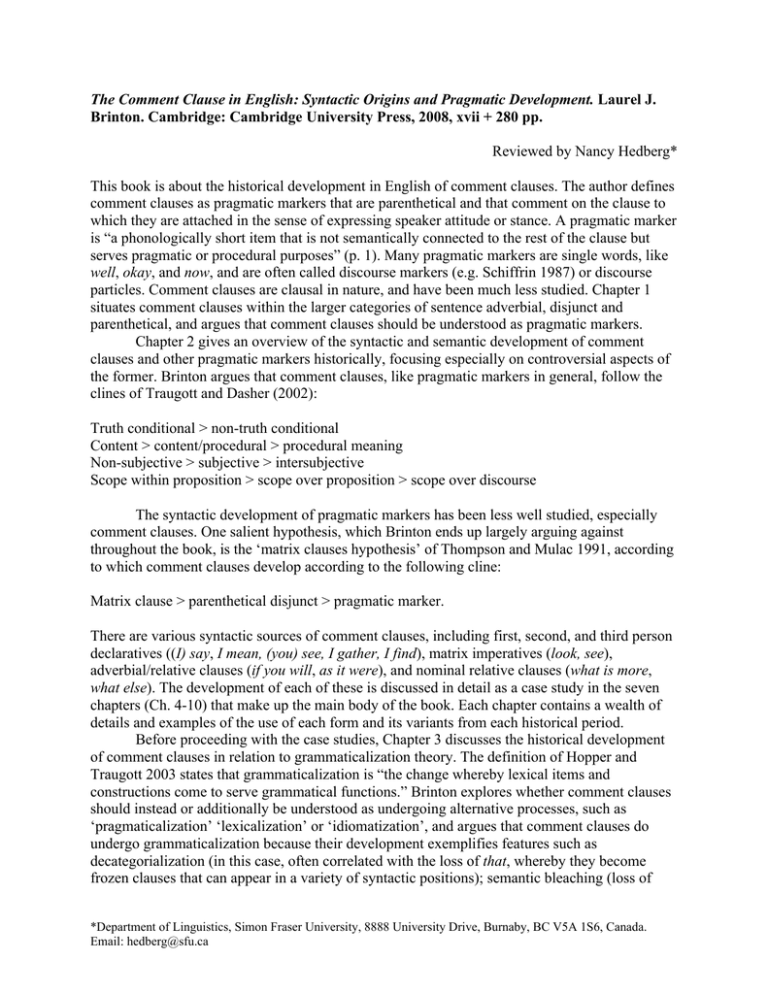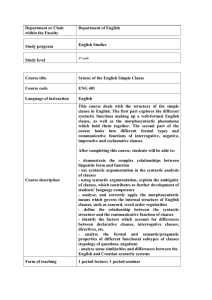This book is about the historical development in English of... comment clauses as pragmatic markers that are parenthetical and that... The Comment Clause in English: Syntactic Origins and Pragmatic Development.
advertisement

The Comment Clause in English: Syntactic Origins and Pragmatic Development. Laurel J.
Brinton. Cambridge: Cambridge University Press, 2008, xvii + 280 pp.
Reviewed by Nancy Hedberg*
This book is about the historical development in English of comment clauses. The author defines
comment clauses as pragmatic markers that are parenthetical and that comment on the clause to
which they are attached in the sense of expressing speaker attitude or stance. A pragmatic marker
is “a phonologically short item that is not semantically connected to the rest of the clause but
serves pragmatic or procedural purposes” (p. 1). Many pragmatic markers are single words, like
well, okay, and now, and are often called discourse markers (e.g. Schiffrin 1987) or discourse
particles. Comment clauses are clausal in nature, and have been much less studied. Chapter 1
situates comment clauses within the larger categories of sentence adverbial, disjunct and
parenthetical, and argues that comment clauses should be understood as pragmatic markers.
Chapter 2 gives an overview of the syntactic and semantic development of comment
clauses and other pragmatic markers historically, focusing especially on controversial aspects of
the former. Brinton argues that comment clauses, like pragmatic markers in general, follow the
clines of Traugott and Dasher (2002):
Truth conditional > non-truth conditional
Content > content/procedural > procedural meaning
Non-subjective > subjective > intersubjective
Scope within proposition > scope over proposition > scope over discourse
The syntactic development of pragmatic markers has been less well studied, especially
comment clauses. One salient hypothesis, which Brinton ends up largely arguing against
throughout the book, is the ‘matrix clauses hypothesis’ of Thompson and Mulac 1991, according
to which comment clauses develop according to the following cline:
Matrix clause > parenthetical disjunct > pragmatic marker.
There are various syntactic sources of comment clauses, including first, second, and third person
declaratives ((I) say, I mean, (you) see, I gather, I find), matrix imperatives (look, see),
adverbial/relative clauses (if you will, as it were), and nominal relative clauses (what is more,
what else). The development of each of these is discussed in detail as a case study in the seven
chapters (Ch. 4-10) that make up the main body of the book. Each chapter contains a wealth of
details and examples of the use of each form and its variants from each historical period.
Before proceeding with the case studies, Chapter 3 discusses the historical development
of comment clauses in relation to grammaticalization theory. The definition of Hopper and
Traugott 2003 states that grammaticalization is “the change whereby lexical items and
constructions come to serve grammatical functions.” Brinton explores whether comment clauses
should instead or additionally be understood as undergoing alternative processes, such as
‘pragmaticalization’ ‘lexicalization’ or ‘idiomatization’, and argues that comment clauses do
undergo grammaticalization because their development exemplifies features such as
decategorialization (in this case, often correlated with the loss of that, whereby they become
frozen clauses that can appear in a variety of syntactic positions); semantic bleaching (loss of
*Department of Linguistics, Simon Fraser University, 8888 University Drive, Burnaby, BC V5A 1S6, Canada.
Email: hedberg@sfu.ca
referential meaning); acquisition of discourse, pragmatic and politeness features; increased
subjectivity; and sometimes phonological attrition.
As mentioned, the body of the book is taken up with case studies of the development of
some interesting comment clauses, which have been little studied for the most part. The data is
taken from a variety of corpora, including the Oxford English Dictionary quotation bank for all
periods, and additional written corpora from five periods: Old English, Middle English, Early
Modern English, Late Modern English, and Present Day English. For Present Day English,
Brinton examined corpora of British, American, Canadian, Australian and New Zealand English
and offers some comparisons between the different varieties. She doesn’t include much
comparison between synchronic varieties, but I believe the volume will still be of interest to
researchers in World Englishes because it demonstrates clearly how comment clauses can arise
in the development of a variety.
The first case study is discussed in Chapter 4, which examines comment clauses with say.
Say with alternatives let's say and I say represents the comment clause with the widest variety of
distinguishable meanings and syntactic categories. Brinton identifies eight meanings and submeanings here, including say1 meaning 'suppose, assume', and say4 meaning 'tell me/us', both of
which can be analyzed as imperative verbs; say2 meaning 'about, approximately' and say3
meaning 'for example, suppose, let's imagine' (both of which can usually be replaced by 'like' in
youthful contemporary spoken English) and which can be analyzed as adverbs; say5a, used to
express a mild emotional response, say5b, used to call or evoke the hearer's attention, and I say6b
used to express emphasis that the speaker has chosen certain words, all of which can perhaps be
analyzed as interjections; and finally I say6a involves a subject plus a main verb and is used again
to clarify or explain the use of words. These different senses arose at different times in English,
with at least say4 and say6 dating back to the Middle English period. Brinton concludes that say14
originate as second-person imperative verbs with clausal complements, with 'let's say'
developing later from some of these forms; and that say5-6 originate from matrix 'I say' with
clausal or nominal complements—although the matrix clause hypothesis is still problematic here
because only 18% of the 180 Middle English examples of I say occurred with a complement
clause.
Chapter 5 examines the very frequent I mean. Schiffrin (1987) distinguishes two full
meanings of 'I mean', which Brinton identifies as 'to intend [to do something]' (which is rare in
Present Day English), and 'to signify, to intend to convey a certain sense.' She also recognizes
four extended meanings: appositional uses of exemplification or repair (recent), or a
reformulation or a greater degree of explicitness (older); causal meanings—'I'm saying this
because…' (recent); expressions of speaker attitude (older); and interpersonal meaning (older).
Brinton argues that parenthetical uses of I mean arise neither from a full matrix clause
construction (I mean (that) S), usage of which has always been rare, nor from an
adverbial/relative structure ({as/to/which} I mean), but rather from I mean + phrasal category
(NP, VP, AP, PP, AdvP).
Chapter 6 looks at see. You see has been found to be more frequent in British than in
American English, and Brinton's corpus findings support this. It is used to claim addressee
attention and to mark transitions between arguments. Parenthetical as you see (dating from 1300
in the OED), so you see (dating from 1626), and see (dating from 1952) are less frequent.
Brinton identifies the origins of see in parenthetical imperative forms see here and see now,
which date from the 16th century, and identifies the origin of you see in as you see.
Chapter 7 focuses on if you will and as it were. These have much the same metalinguistic
meaning. This sense of as it were dates back to Middle English and was possibly influenced by
the Latin quasi, while this sense of if you will is much more recent. If you will appears to be more
grammaticalized in Canadian English than in British English, since it is used parenthetically
proportionately more frequently in the Canadian corpus.
Chapter 8 discusses look, which has imperative origins and occurs in several variants,
including look here and lookit. Look and its variants as parentheticals primarily have an attention
getting function rather than a concrete perceptual meaning. Non-concrete usage of look alone
extends only back to the Early Modern English period.
Chapter 9 looks at what's more and what else. The former dates back only to the end of
th
the 16 century, and along with which is more has its origins as a relative clause modifying a
clausal element. What else originates as an elliptical interrogative construction, and dates only to
Early Modern English as a comment clause.
Chapter 10 compares I gather and I find, and situates them in the class of epistemic
parentheticals, such as I think and I guess. Brinton reports that I gather that is more frequent than
I gather Ø in Canadian English; while the opposite is true in British English. I find in general is
much more frequent than I gather, but parenthetical uses are less frequent. Brinton argues that I
find originates in the parenthetical as I find, which dates from Middle English, rather than from a
matrix clause. The parenthetical I gather, however, likely originates from a matrix clause. I find
has conveyed a non-concrete meaning when functioning as comment clauses since Middle
English, but I gather as a comment clause only dates to the late 19th century.
The concluding chapter of the book summarizes the findings, especially regarding
conclusions about the dating and syntactic sources of the different comment clauses discussed,
and how their development exhibits features of grammaticalization. The author concludes that
Construction Grammar (e.g. Kay 1997) should be a good syntactic framework for the further
study of comment clauses, since such clauses appear to be constructions par excellence—that is,
conventionalized chunks of language with identifiable syntactic, semantic and pragmatic
features, that have autonomy and can fruitfully be studied as a package.
This book fills a gap in the study of pragmatic markers, and is thorough and detailed in its
coverage. I highly recommend it.
REFERENCES
Hopper, Paul J. and Elizabeth Closs Traugott (2003). Grammaticalization, 2nd edition.
Cambridge: Cambridge University Press.
Kay, Paul (1997). Construction Grammar. In Words and the Grammar of ContextI, Stanford,
CA: Center for the Study of Language and Information. 123-131.
Schiffrin, Deborah (1987). Discourse Markers. Cambridge: Cambridge University Press.
Thompson, Sandra A. and Anthony Mulac (1991). A quantitative perspective on the
grammaticalization of epistemic parentheticals in English. In Traugott, Elizabeth Closs and
Bernd Heine, eds. Approaches to Grammaticalization, Amsterdam and Philadelphia: John
Benjamins. 313-329.
Traugott, Elizabeth Closs and Richard B. Dasher (2002). Regularity in Semantic Change.
Cambridge: Cambridge University Press.
(Received 1 November 2009)




